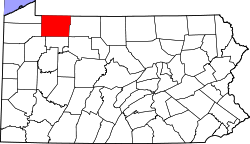Brokenstraw Township, Warren County, Pennsylvania
| Brokenstraw Township | |
|---|---|
| Township | |

Irvine United Presbyterian Church, a historic site in the township
|
|
 Location of Brokenstraw Township in Warren County |
|
 Location of Warren County in Pennsylvania |
|
| Country | United States |
| State | Pennsylvania |
| County | Warren County |
| Area | |
| • Total | 38.8 sq mi (100 km2) |
| • Land | 38.6 sq mi (100 km2) |
| • Water | 0.2 sq mi (0.5 km2) |
| Population (2000) | |
| • Total | 2,098 |
| • Density | 54/sq mi (21/km2) |
| Time zone | EST (UTC-4) |
| • Summer (DST) | EDT (UTC-5) |
| Area code(s) | 814 |
Brokenstraw Township is a township in Warren County, Pennsylvania, United States. It was formed in 1800. The population was 2,068 at the 2000 census.
According to the United States Census Bureau, the township has a total area of 38.8 square miles (100 km2), of which 38.6 square miles (100 km2) is land and 0.2 square miles (0.52 km2) (0.41%) is water.
In 1797, 22-year-old Callender Irvine, the United States Army's Commissary General, and son of General William Irvine, settled in Brokenstraw Township. He "reported that there were more Indians in the area then than whites."
Callender built a "stately white mansion ... on the banks of the Allegheny in 1822," overlooking Crull's Island. "Callender Irvine's brother, Dr. John W. Irvine shared in the management of the [general] store, along with Robinson R. Moore, until 1820, after which he practiced medicine in Brokenstraw."
William A. Irvine, M.D., another son of Callender's, settled in Brokenstraw in 1825, and
spent his life attempting to turn the Irvine property to profitable commercial ventures. Among his many enterprises were a lumbering business, the general store started by his father, a wool factory, an iron foundry, and further speculation ... his farm, internal improvements ... the blacksmith shop ... and the Irvine post office. In the mid-1850's, Irvine was forced to give up most of his business, retaining the farm, the lumbering concern, and land on which he later developed oil.
His wife was Sarah Duncan Irvine; their daughter was Sarah Irvine Newbold. The mansion and property were known locally as the "Irving Estate" or "Newbold Estate." Esther Newbold, great-granddaughter of Callender, was the last generation of the family to live in the mansion. She "had studied law in Philadelphia and was known for keeping up on legislative matters in Harrisburg." Esther died in 1963 at almost 90 years of age, and the home was razed ten years later, in 1973.
A model of the house was made for the nearby Clinton E. Wilder Museum.
...
Wikipedia
